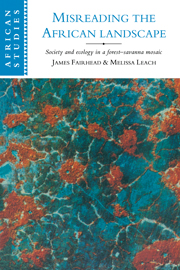Book contents
- Frontmatter
- Contents
- List of plates
- List of figures
- List of tables
- Note on authorship and research collaboration
- Acknowledgements
- Linguistic conventions
- Introduction
- 1 Convictions of forest loss in policy and ecological science
- 2 Forest gain: historical evidence of vegetation change
- 3 Settling a landscape: forest islands in regional social and political history
- 4 Ecology and society in a Kuranko village
- 5 Ecology and society in a Kissi village
- 6 Enriching a landscape: working with ecology and deflecting successions
- 7 Accounting for forest gain: local land use, regional political economy and demography
- 8 Reading forest history backwards: a century of environmental policy
- 9 Sustaining reversed histories: the continual production of views of forest loss
- 10 Towards a new forest–savanna ecology and history
- Appendix I Glossary of plant names
- Appendix II Cassette recordings of oral accounts and discussions
- Notes
- List of references
- Index
- Titles in the series
- Plate section
7 - Accounting for forest gain: local land use, regional political economy and demography
Published online by Cambridge University Press: 05 June 2012
- Frontmatter
- Contents
- List of plates
- List of figures
- List of tables
- Note on authorship and research collaboration
- Acknowledgements
- Linguistic conventions
- Introduction
- 1 Convictions of forest loss in policy and ecological science
- 2 Forest gain: historical evidence of vegetation change
- 3 Settling a landscape: forest islands in regional social and political history
- 4 Ecology and society in a Kuranko village
- 5 Ecology and society in a Kissi village
- 6 Enriching a landscape: working with ecology and deflecting successions
- 7 Accounting for forest gain: local land use, regional political economy and demography
- 8 Reading forest history backwards: a century of environmental policy
- 9 Sustaining reversed histories: the continual production of views of forest loss
- 10 Towards a new forest–savanna ecology and history
- Appendix I Glossary of plant names
- Appendix II Cassette recordings of oral accounts and discussions
- Notes
- List of references
- Index
- Titles in the series
- Plate section
Summary
In this chapter we examine more closely how the varied social and ecological conditions already considered have articulated with broader demographic, economic and political changes during the present century in affecting patterns of vegetation change at the prefecture level. As we have seen, people have many ways to influence ecology, but actual practice – and aggregate actual practice with large impacts on landscape – has responded to diverse and changing social and economic conditions. Considerations of Toly and Sandaya have exemplified some of these changes, and their workings at the level of local social relations, but given the prefecture's considerable diversity, these issues must be addressed at a larger scale. Thus while the last chapter examined ecological practices within different localities across the forest–savanna transition at the prefecture scale, this chapter sets their application within the different socio-economic and demographic histories of these localities during the present century.
Our strategy is to focus on the major influences on land use in several domains of particular importance in deflecting upland vegetation succession: forest island management, farming, the cattle economy and fire control. In this we are able to go some way towards accounting for the patterns of vegetation change demonstrated in chapter 2. Nevertheless, such explanation must inevitably remain tentative, not least because of the complexity of interacting factors in each locality. Furthermore, we leave consideration of a further important set of influences – environmental policy and interventions – to the next chapter.
- Type
- Chapter
- Information
- Misreading the African LandscapeSociety and Ecology in a Forest-Savanna Mosaic, pp. 210 - 236Publisher: Cambridge University PressPrint publication year: 1996



